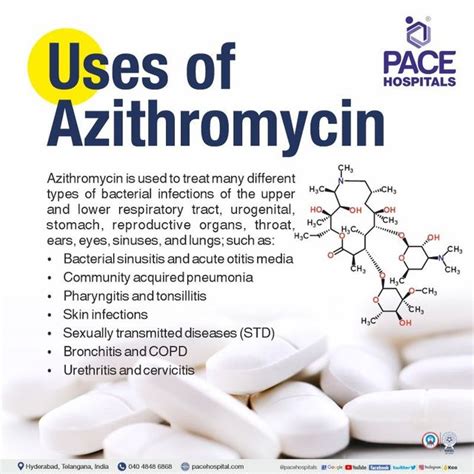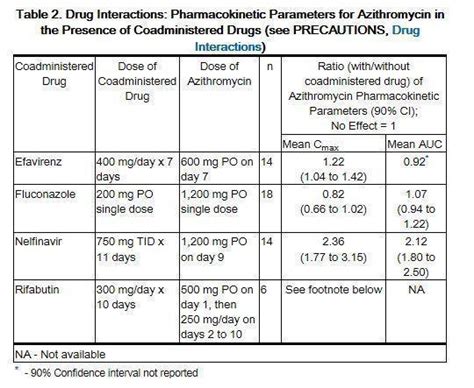Intro
The discovery of antibiotics has revolutionized the field of medicine, enabling doctors to effectively treat bacterial infections that were once deadly. Among the various antibiotics available, azithromycin has emerged as a popular choice due to its broad-spectrum activity and favorable safety profile. As a macrolide antibiotic, azithromycin has been widely used to treat a range of bacterial infections, including respiratory tract infections, skin infections, and sexually transmitted diseases. In this article, we will delve into the uses of azithromycin, its mechanism of action, and its benefits, as well as discuss potential side effects and interactions.
Azithromycin is a semi-synthetic derivative of erythromycin, a naturally occurring macrolide antibiotic. Its broad-spectrum activity makes it effective against a wide range of gram-positive and gram-negative bacteria, including Streptococcus pneumoniae, Haemophilus influenzae, and Moraxella catarrhalis. The antibiotic works by inhibiting protein synthesis in bacteria, ultimately leading to their death. This mechanism of action is distinct from that of other antibiotics, such as beta-lactams, which work by inhibiting cell wall synthesis.
The use of azithromycin has become increasingly common due to its convenience and efficacy. Unlike other antibiotics that require multiple daily doses, azithromycin can be taken once daily, making it easier for patients to adhere to their treatment regimen. Additionally, azithromycin has a relatively long half-life, allowing it to remain in the body for an extended period and providing sustained antibacterial activity.
Azithromycin Uses

Azithromycin is used to treat a variety of bacterial infections, including:
- Respiratory tract infections, such as pneumonia, bronchitis, and sinusitis
- Skin infections, such as impetigo, folliculitis, and cellulitis
- Sexually transmitted diseases, such as chlamydia and gonorrhea
- Ear infections, such as otitis media and otitis externa
- Eye infections, such as conjunctivitis and blepharitis
Respiratory Tract Infections
Azithromycin is commonly used to treat respiratory tract infections, including pneumonia, bronchitis, and sinusitis. Its broad-spectrum activity makes it effective against a range of bacteria that cause these infections, including Streptococcus pneumoniae, Haemophilus influenzae, and Moraxella catarrhalis. Studies have shown that azithromycin is as effective as other antibiotics, such as amoxicillin and clarithromycin, in treating respiratory tract infections.Azithromycin Mechanism of Action

Azithromycin works by inhibiting protein synthesis in bacteria. It binds to the 50S subunit of the bacterial ribosome, preventing the translation of messenger RNA into proteins. This ultimately leads to the death of the bacterial cell. Azithromycin's mechanism of action is distinct from that of other antibiotics, such as beta-lactams, which work by inhibiting cell wall synthesis.
Azithromycin Benefits
The use of azithromycin offers several benefits, including: * Convenience: Azithromycin can be taken once daily, making it easier for patients to adhere to their treatment regimen. * Efficacy: Azithromycin is effective against a wide range of bacteria, including those that cause respiratory tract infections, skin infections, and sexually transmitted diseases. * Safety: Azithromycin has a relatively low risk of side effects, making it a safe choice for patients.Azithromycin Side Effects

While azithromycin is generally well-tolerated, it can cause side effects in some patients. Common side effects include:
- Gastrointestinal symptoms, such as nausea, vomiting, and diarrhea
- Headache and dizziness
- Fatigue and weakness
- Rash and itching
Azithromycin Interactions
Azithromycin can interact with other medications, including: * Warfarin: Azithromycin can increase the risk of bleeding when taken with warfarin. * Digoxin: Azithromycin can increase the levels of digoxin in the body, leading to toxicity. * Cyclosporine: Azithromycin can increase the levels of cyclosporine in the body, leading to toxicity.Azithromycin Dosage

The dosage of azithromycin varies depending on the infection being treated. Typical dosages include:
- Respiratory tract infections: 500 mg once daily for 3-5 days
- Skin infections: 500 mg once daily for 3-5 days
- Sexually transmitted diseases: 1 g once daily for 1 day
Azithromycin Precautions
Patients taking azithromycin should be aware of the following precautions: * Allergic reactions: Patients who are allergic to azithromycin or other macrolide antibiotics should not take azithromycin. * Pregnancy and breastfeeding: Azithromycin is generally safe during pregnancy and breastfeeding, but patients should consult their doctor before taking the medication. * Liver and kidney disease: Patients with liver or kidney disease should use azithromycin with caution, as it can increase the risk of side effects.Azithromycin Resistance

The overuse and misuse of azithromycin have contributed to the development of antibiotic resistance. Patients should only take azithromycin as directed by their doctor, and should not share the medication with others. Additionally, patients should complete the full course of treatment, even if symptoms improve before finishing the medication.
Azithromycin Alternatives
Patients who are allergic to azithromycin or who experience side effects may be prescribed alternative antibiotics. These include: * Amoxicillin * Clarithromycin * Doxycycline * CiprofloxacinAzithromycin Conclusion and Future Directions

In conclusion, azithromycin is a valuable antibiotic that has been widely used to treat a range of bacterial infections. Its broad-spectrum activity, convenience, and efficacy make it a popular choice among doctors and patients. However, the development of antibiotic resistance and the potential for side effects highlight the need for responsible use and further research into the development of new antibiotics.
As we move forward, it is essential to continue monitoring the use of azithromycin and other antibiotics to minimize the risk of resistance and side effects. Additionally, researchers should continue to explore new antibiotics and alternative treatments to stay ahead of the evolving landscape of bacterial infections.
What is azithromycin used for?
+Azithromycin is used to treat a variety of bacterial infections, including respiratory tract infections, skin infections, and sexually transmitted diseases.
How does azithromycin work?
+Azithromycin works by inhibiting protein synthesis in bacteria, ultimately leading to their death.
What are the common side effects of azithromycin?
+Common side effects of azithromycin include gastrointestinal symptoms, headache, and dizziness.
Can I take azithromycin if I am pregnant or breastfeeding?
+Azithromycin is generally safe during pregnancy and breastfeeding, but patients should consult their doctor before taking the medication.
How can I minimize the risk of antibiotic resistance when taking azithromycin?
+Patients should only take azithromycin as directed by their doctor, complete the full course of treatment, and not share the medication with others.
We hope this article has provided you with a comprehensive understanding of azithromycin and its uses. If you have any further questions or would like to share your experiences with azithromycin, please don't hesitate to comment below. Additionally, if you found this article informative, please share it with others who may benefit from this information.
